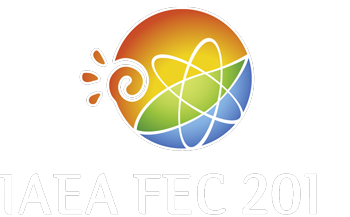Speaker
Dr
Zixi Liu
(Princeton Plasma Physics Laboratory / Institute of Plasma Physics, Chinese Academy of Sciences)
Description
The weakly coherent mode (WCM) in I-mode has been studied by six-field two-fluid model based on the Braginskii equations under the BOUT++ framework. The calculations indicate that a tokamak pedestal exhibiting a WCM is unstable to drift Alfven wave (DAW) instabilities and resistive ballooning mode. The nonlinear simulation shows promising agreement with the experimental measurements of WCM. The spectrum of the largest toroidal number mode n=20 at the location of the reflectometry agrees with the experimental data. The mode propagating in electron diamagnetic direction is consistent with the results from the magnetic probes, a large ratio of particle to heat diffusivity is consistent with the distinctive experimental feature of I-mode, and the value of the electron thermal diffusivity from simulation is almost as same as the effective thermal diffusivity from the experiment. The prediction of the WCM shows that free energy is mainly provided by the electron pressure gradient, which gives a well guidance for pursuing future I-mode studies.
| Country or International Organization | USA |
|---|---|
| Paper Number | TH/P2-28 |
Author
Dr
Zixi Liu
(Princeton Plasma Physics Laboratory / Institute of Plasma Physics, Chinese Academy of Sciences)
Co-authors
Dr
Amanda Hubbard
(Massachusetts Institute of Technology, Plasma Science and Fusion Center)
Mr
C. Theiler
(MIT Plasma Science and Fusion Center, Cambridge MA, USA)
Prof.
Dennis Whyte
(MIT Plasma Science Fusion Center)
Mr
J. R. Walk
(MIT Plasma Science and Fusion Center, Cambridge MA, USA)
Jerry Hughes
(MIT PSFC)
Prof.
Jiangang Li
(Institute of Plasma Physics, Chinese Academy of Sciences)
Mr
S. G. Baek
(MIT Plasma Science and Fusion Center, Cambridge MA, USA)
Dr
Tao Zhang
(Institute of Plasma Physics, Chinese Academy of Sciences, Hefei, China)
Mr
Theodore Golfinopoulos
(Plasma Science and Fusion Center, Massachusetts Institute of Technology)
Mr
Tianyang XIa
(Institute of Plasma Physics, Chinese Academy of Sciences)
Prof.
Xiang Gao
(Institute of Plasma Physics, Chinese Academy of Sciences)
Xueqiao Xu
(Lawrence Livermore National Laboratory)

